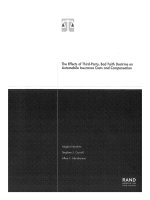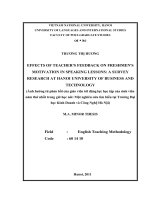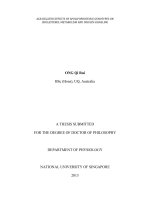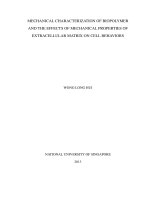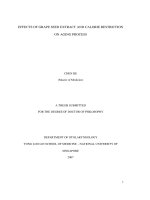Chronic effects of lead and arsenic on life history traits of Daphnia magna
Bạn đang xem bản rút gọn của tài liệu. Xem và tải ngay bản đầy đủ của tài liệu tại đây (868.14 KB, 6 trang )
Environmental Sciences | Ecology
Doi: 10.31276/VJSTE.61(4).82-87
Chronic effects of lead and arsenic on life
history traits of Daphnia magna
Le-Thu Quach1, Thi-My-Chi Vo2, Van-Tai Nguyen2, Thanh-Son Dao2*
1
Ho Chi Minh city University of Food Industry
University of Technology, Vietnam National University, Ho Chi Minh city
2
Received 22 August 2019; accepted 12 November 2019
Abstract:
Introduction
Anthropogenic activities such as industrial production,
mining, agriculture and transportation are among
the main causes for the increase of trace metal
concentrations in the environment, especially in water
bodies. In this study, we evaluated the chronic impacts
of lead (Pb) and arsenic (As) on Daphnia magna, a
crucial organism to aquatic ecosystems, at several
concentrations (0, 5, 25, 50, 150 and 250 µgl-1 of Pb and
0, 5, 25, 50 µgl-1 of As) for 21 days. The organism’s life
history traits, including survivorship, maturation, and
reproduction, were recorded daily. In addition, the
survival rate of the offspring exposed to 50 µgl-1 Pb was
also recorded when the animals were raised in (i) a Pbcontaining medium and Pb-free medium for 8 days. The
results showed that As, at all the test concentrations,
did not only negatively affect the survival and
cause a delay the maturation, but also reduced the
reproductive performance of the animal, especially at
the highest concentration. Compared to the control, the
survivorship and reproduction of the D. magna exposed
to Pb at the highest concentrations (150 and 250 µgl-1)
declined dramatically, and it took a longer time to reach
maturity. On the other hand, almost all of the recorded
life history traits of the organisms exposed to 5, 25 and
50 µgl-1 of Pb were relatively similar to those from the
control. However, Pb at the concentration of 50 µgl-1
had detrimental effect on survival of Daphnia’s F1
generation after the 8-day experiment. An abnormality
of the metal-exposed D. magna was also observed.
An impairment of the daphnids was observed upon
exposures to As and Pb at concentrations within the
Vietnam guideline values for surface water safety.
Hence, further investigations are suggested to adjust
the guidelines related to As and Pd for the protection on
environmental quality and ecological health.
Over the past decades, trace metals have been one of the
most serious chemical contaminants causing environmental
pollution and potential toxicity to human health and
organisms [1, 2]. Some trace metals (e.g. Cu, Cr, Mg, Mn,
Zn, Ni, Fe and Co with the concentration less than 10 µgl-1)
are essential elements for the physiological and biochemical
functions of organisms [3], yet when exceeding a certain
concentration, they could cause negative effects [4]. Besides,
some other trace meals such as Pb, As, Cd, Hg are not only
non-essential elements for biological functions of organisms,
but also potent toxins to living things [5-7]. They can
adversely affect cellular organelles and components, such
as cell membranes, mitochondria, lysosomes, endoplasmic
reticula, nuclei, some metabolic enzymes, detoxification
processes, and damage repair mechanisms [8, 9], hence trace
metals interfere with critical life processes of organism.
Recently, there has been an abundance of evidence of
aquatic pollution caused by trace metals worldwide [10-12].
In Vietnam, due to rapid economic development, the
surface water quality is under constant threat of trace metal
contamination, especially with Pb and As [13, 14]. Trace
metals are naturally and commonly occurring elements
in the Earth’s crust, however in surface water, the main
sources of trace metal, particularly As and Pb, are emission
from anthropogenic activities e.g. metal plating, fishing
operations, battery manufacturing, fertilizers and pesticides
in agriculture, and smelting of ores [4, 15].
Keywords: chronic effects, Daphnia magna, guideline,
life history traits, trace metals.
Classification number: 5.1
Both Pb and As are classified as top human carcinogens
[5]. Additionally, Pb and As are non-essential elements
for organisms and considered a major cause of aquatic
environmental pollution due to the mechanism of chronic
bioaccumulation and toxicity at low concentrations [16].
The presence of Pb in the environment was shown to cause
behavioural abnormalities, hearing deficits, neuromuscular
weakness, and shown to impair cognitive functions in
human being as well as wildlife [17]. Regarding As,
*Corresponding author: Email:
82
Vietnam Journal of Science,
Technology and Engineering
DECEMBER 2019 • Vol.61 Number 4
Environmental Sciences | Ecology
exposure to this chemical might affect several different
organ systems including skin, respiratory, cardiovascular,
immune, genitourinary, reproductive, gastrointestinal, and
nervous system [18, 19].
Microcrustaceans (e.g. D. magna) play an important role
in aquatic ecosystems as they are vital intermediate trophic
level organisms responsible for the passage of matter and
energy between primary producers and top predators [20].
Hence, in order to assess the ecological risk of Pb and As, a
large number of studies have been completed on the chronic
and semi-chronic effects of Pb and As on the life history
traits of zooplankton. Many studies [21-24] indicated that
there were various detrimental impacts on the health of
test organisms when they were exposed to trace metals.
In surface water, As and Pb could reach concentrations of
0.64 mgl-1 (see in the study of Frisbie, et al. (2002) [25])
and 6.3 mgl-1 (see in the study of Vuković, et al. (2011)
[26]), respectively. For environmental and ecological
safety in Vietnam, the As and Pb concentrations should
not exceed 50 µgl-1 [27]. However, the question of whether
there is any the impact of these trace metals on D. magna
at low concentrations during a long-term exposure and
across generations has not been addressed. Therefore, this
study aims to evaluate the chronic effects of Pb and As at
concentrations ranging from 5-250 µgl-1 on the life history
traits and the next generation of D. magna.
Materials and methods
Materials
D. magna was obtained from MicroBio Test (Belgium)
and has been cultured in a medium called ISO [28] for
many generations under laboratory conditions (temperature
of 25±10C and a photoperiod of 14 h light: 10 h dark at
a light intensity of around 1000 Lux) [29]. Both the stock
chemicals Pb(NO3)2 and As(NO3)3 at a concentration of
1000 mgl-1 were purchased from Merck (Germany) and
stored at the temperature of -40C prior to the experiment.
Experimental set up
The chronic experiments were performed according to
the guideline of APHA (2012), US. EPA (2002) and Dao, et
al. (2017) [29-31] with minor adjustments. Briefly, prior to
the experiment, 50 healthy female Daphnia were collected
and incubated in the 1 l glass beaker containing 800 ml of
ISO medium and fed with a mixture of green alga (Chlorella
sp.) and YTC (yeast, cerrophyl and trout chow digestion).
Afterwards, offspring less than 24 hours old were randomly
selected for the chronic experiments.
In the first test, 2 neonates were incubated together in
one 50 ml polypropylene cup containing 40 ml ISO medium
and exposed to either Pb at a concentration of 5, 25, 50, 150,
and 250 µgl-1 or As at a concentration of 5, 25, and 50 µgl-1.
Moreover, a control was prepared by culturing the offspring
in the same way as mentioned above in a metal-free
medium. There were 15 replicates (n=15) in each treatment
and the test organisms were cultured under the conditions
as mentioned above. The food (a mixture of Chlorella sp.
and YTC) and medium were completely renewed three
times per week. During the experimental period of 21 days,
the life history traits of D. magna, such as survivorship,
maturation, and reproductive performance, were monitored
daily and carefully recorded.
The offspring of D. magna (<24 hours in age) in the
control and 50 µgl-1 of Pb exposure were collected and
used for the second test. Briefly, the offspring from the
control were continued to culture in the control medium.
Meanwhile, the neonates from 50 µgl-1 of Pb exposure were
separated into 2 groups: i) those continuing to culture in
the control medium and ii) those continuing to be exposed
to 50 µgl-1 of Pb. In each treatment with the offspring, 30
offspring were used and incubated in 15 polypropylene cups
(n=15), hence two offspring were placed in one cup. This
experiment was run under the same laboratory conditions
as mentioned above. The test terminated after 8 days of
incubation and the survival of organisms was recorded.
Data analyses
Sigma Plot version 12.0 was used for the data processing.
The Kruskal-Wallis test was applied for calculating the
statistically significant difference of the maturation of D.
magna between the control and trace metal exposures.
Results and discussion
Effects of Pb and As on the survivorship of D. Magna
As showed in Fig. 1, at the end of the experiment,
all D. magna were still thriving in the control sample.
Similarly, the survival rate of the organisms exposed to the
lowest concentrations (5, 25 and 50 µgl-1) of Pb was 100%
during the 21 experimental days. However, after only 3 days
of experiment, exposure to Pb at the concentrations of 150
and 250 µgl-1 caused a dramatic reduction of 20 and 77% of
the total daphnids, respectively. By the end of the test, all
D. magna exposed to the two highest concentrations of Pb
had died (Fig. 1A). During the 8 first days, the survival of
the organisms exposed to As at concentrations ranging from
5-50 µgl-1 remained steady at 100%, the same as those in
the control sample, but this significantly decreased during
the remainder of the As exposure. Finally, only 30, 63, and
17% of the total number of D. magna exposed to 5, 25, and
50 µg As l-1, respectively, remained alive (Fig. 1B).
DECEMBER 2019 • Vol.61 Number 4
Vietnam Journal of Science,
Technology and Engineering
83
Environmental Sciences | Ecology
Effects of Pb and As on the maturation of D. Magna
A metal may affect an organism in more than one way
[40], hence, the time it takes for animals to reach maturity
can be affected by exposure to Pb and As. In the control and
Pb treatments (5-50 µgl-1), the maturity age of D. magna
was around 4 days. However, exposure to Pb at the two
highest concentrations, 150 and 250 µgl-1 Pb, the maturation
of Daphnia was prolonged to 12 and 8 days, respectively
(Fig. 2A).
Fig. 1. Survivorship of D. magna from control and exposures
during 3 experimental weeks (n=30 at the beginning). Samples
denoted Pb 5, Pb 25, Pb 50, Pb 150, Pb 250 are animals exposed
to 5, 25, 50, 150, 250 µgl-1 Pb, respectively, and As 5, As 25, As
50 denote animals exposed to 5, 25, 50 µgl-1 As, respectively.
There was no statistically significant difference in the
age to maturation between the control and those exposed to
25 µgl-1 As. The animals incubated in As at a concentration
of 5 and 50 µgl-1 delayed their maturation compared to
the control, and they did not mature until the ages of
approximately 5 and 6 days, respectively (Fig. 2B). Overall,
exposure to trace metals caused a postponement of the
maturation of the animals, especially the microcrustaceans,
that were observed in several previous investigations [31,
41, 42]. Trace metals at high concentration could negatively
impair the respiratory function of daphnids [33] and
inhibit their sodium uptake leading to an increased energy
cost for maintenance [32], which may help to explain the
postponement on the maturation.
Aquatic animals upon exposure to high metal
concentrations would suffer from several impacts such as
organ dysfunction, physiological imbalance, and enzyme
inhibition/stimulation [32-35]. Pb is a neurotoxic chemical
that can affect an organism’s gills (respiratory system), cause
renal dysfunction, enzymatic inhibition, and anemia [36,
37], resulting in increased energy cost for normal activity
and maintenance of the animals. Besides, the metal may
reduce food filtering, consequently lowering energy intake
[38]. To summarize, in the presence of metals (e.g. Pb),
D. magna would suffer an energy cost and consequently a
decline in the survivorship. Additionally, our results were
in line with the previous study of Regaldo, et al. (2013),
although the survival of D. magna exposed to 30 µgl-1 Pb
reached 100%, those exposed to this chemical at 90 and 270
µgl-1 declined to 10% after 15 days [21].
In the As exposure experiments, the animals exposed
to As at a moderate concentration of 25 µgl-1 had a higher
survival rate than those exposed to 5 µgl-1 and 50 µgl-1
concentrations. This phenomenon might be explained by
hormesis, a term used to refer to a biphasic dose response
characterized by a low-dose stimulation and a high-dose
inhibition [39]. Further investigations on the physiological
and biochemical responses of D. magna upon exposure to
As are suggested to clarify this response.
84
Vietnam Journal of Science,
Technology and Engineering
Fig. 2. Maturity age of D. magna (mean value ±SD) chronically
exposed to Pb and As. Abbreviations given in Fig. 1. The asterisk
indicates a statistically significant difference between the control
and exposures by the Kruskal Wallis test (*: p≤0.001).
DECEMBER 2019 • Vol.61 Number 4
Environmental Sciences | Ecology
Effects of Pb and As on the reproduction of D. Magna
During the three weeks of incubation, the total number of
offspring in the control was 3301, which was comparable to
the total neonates in the exposures to Pb at low concentrations
of 5, 25 and 50 µgl-1. In contrast, the accumulative offspring
in the 150 and 250 µgl-1 Pb exposures were only 42 and
5, respectively, which is much far lower than those in the
control (Table 1). Regarding all the As exposures, a decline
in the reproductive performance of D. magna was recorded.
The As treatments (5, 25 and 50 µgl-1) resulted in a reduction
to 14, 35, and 7%, respectively, as compared to the total
offspring in control (Table 1). That could be explained by
the detrimental impacts on the organism mentioned above,
such as the increase in mortality and postponement of the
maturation. Moreover, the clutch size (the number of eggs
per clutch) of the animals exposed to Pb at the highest
concentration was smaller than those in the control (Fig. 3).
Table 1. Accumulative offspring of D. magna during the 21
experimental days. Abbreviations are the same as in Fig. 1.
Control Pb 5 Pb 25 Pb 50 Pb 150 Pb 250 As 5
Total neonates 3301
3503 3404
3358
42
5
455
As 25 As 50
1159
246
This observation in consistent with a previous study of
Enserink, et al. (1995) [22] in which the reproduction of D.
magna was negatively influenced by Pb. In detail, exposure
to Pb at a concentration of 920 µgl-1 resulted in the loss of
large number of eggs of the female D. magna and a decrease
in embryo size. More seriously, several abnormal responses
of the organism exposed to 50 µgl-1 of As were recorded,
such as broken and adhesive eggs and neonatal mortality in
the chamber (Fig. 4). These phenomena could significantly
contribute to the decrease of the number of offspring laid by
the female exposed to Pb or As.
Fig. 3. The difference in the clutch size of female D. magna
between the control (A) and exposure to 250 µg Pb l-1 (B).
Fig. 4. Several abnormalities in D. magna exposed to 50 µgl-1 As;
broken egg (A); adhesive eggs (B); death of neonate in the brood
chamber of its mother (C).
Effects of Pb on the survival of the next generation of
D. magna
When organisms from the mothers of the control samples
were allowed to continue to rear in a metal-free medium
(C/C), the survival rate was 83% (Fig. 5), which was within
the requirement of the toxicity test according to APHA
(2012) [29]. More seriously, the survival of the offspring of
the Pb-exposed mothers incubated in both non-metal (E/C)
and metal-containing medium (E/E) dramatically declined
to 3 and 17%, respectively (Fig. 5). The survival rate of E/C
and E/E was not significantly different but within a similar
range to a chronic test according the APHA (2012). Recently,
Araujo, et al. (2019) [24] showed that negative and adverse
effects (e.g. malformations, Pb aggregation in neonates’
dorsal region, reddish extremities, production of males,
ephippia, aborted eggs, changes in egg colour) occurred
through nine generations in both the temperate D. magna
and tropical D. similis after long-term exposure to 50 µgl-1
of Pb. To our knowledge, this was the first investigation on
the trans-generation effects of Pb on D. magna survival.
Fig. 5. Survivorship of the descendants of D. magna from the
control and exposure to 50 µgl-1 of Pb during 8 experimental
days (n=30 at the beginning). C/C: organisms laid in control
and allowed to continue to incubate in the control medium;
E/C: organisms laid in control and exposed to 50 µgl-1 of Pb;
E/E: organisms laid in 50 µgl-1 of Pb and allowed to continue to
culture in the same medium.
DECEMBER 2019 • Vol.61 Number 4
Vietnam Journal of Science,
Technology and Engineering
85
Environmental Sciences | Ecology
Conclusions
The results of this study proved that As and Pb at
concentrations within the Vietnam guideline values for
surface water safety (QCVN 08-MT:2015/BTNMT;
column B1 for both Pb and As are 50 µgl-1) caused several
detrimental impacts on the life history traits of daphnids (e.g.
survivorship, maturation, reproductive performance, and
transgenerational survivorship). Therefore, more attention
should be paid to the presence, distribution, and fate of
trace metals in aquatic environment. Additionally, further
investigations e.g. effects of a combination of more than two
metals, bio-accumulation or mechanism of negative effects,
are suggested in order to gain a greater understanding of
the toxicity of these contaminants on aquatic organisms and
ecosystems.
ACKNOWLEDGEMENTS
The authors would on like to thank Assoc. Prof. Dr.
Pham Hong Nhat, University of Food Industry, for his
valuable comments on this manuscript.
The authors declare that there is no conflict of interest
regarding the publication of this article.
REFERENCES
[1] J.O. Reinhold, A.J. Hendriks, L.K. Slager, M. Ohm (1999),
“Transfer of microcontaminants from sediment to chironomids, and
the risk for the Pond bat Myotis dasycneme (Chiroptera) preying on
them”, Aquatic Ecology, 33(4), pp.363-376.
[2] P.K. Bharti (2012), Heavy Metals in Environment, Lambert
Academic Publishing GmbH & Co. KG.
[3] D.A. Davis, D.M. Gatlin (1996), “Dietary mineral requirement
of fish and marine crustaceans”, Reviews in Fisheries Science, 4(1),
pp.75-99.
[4] M. Jaishankar, T. Tseten, N. Anbalagan, B.B. Mathew, K.N.
Beeregowda (2014), “Toxicity, mechanism and health effects of some
heavy metals”, Interdisciplinary Toxicology, 7(2), pp.60-72.
[5] U.S. Agency for Toxic Substances and Diseases Registry
(ATSDR) (2007), Toxicological Profile for arsenic, Atlanta, Georgia.
[6] P. Govind (2014), “Heavy metals causing toxicity in humans,
animals and environment”, Journal of Chemical and Pharmaceutical
Science, 3(12), pp.172-174.
[7] W. Vincent, A. Hou, G.N. Meng (2015), “Source of lead
pollution, its influence on public”, International Journal of Health,
Animal Science and Food Safety, 2(1), pp.18-31.
[8] K.S. Squibb, B.A. Fowler (1981), “Relationship between
metal toxicity to subcellular systems and the carcinogenic response”,
Environmental Health Perspectives, 40, pp.181-188.
[9] S. Wang, X. Shi (2001), “Molecular mechanisms of metal
toxicity and carcinogenesis”, Molecullar and Cellular Biochemistry,
222(1-2), pp.3-9.
[10] Z. Wang, L. Yao, G. Liu, W. Liu (2014), “Heavy metals in
86
Vietnam Journal of Science,
Technology and Engineering
water, sediments and submerged macrophytes in ponds around the
Dianchi Lake, China”, Ecotoxicology and Environmental Safety, 107,
pp.200-206.
[11] M. Hassan, M.A.T.M.T. Rahman, B. Saha, A.K.I. Kamal
(2015), “Status of heavy metals in water and sediment of the Meghna
river, Bangladesh”, American Journal of Environmental Sciences,
11(6), pp.427-439.
[12] E. Antico, S. Cot, A. Ribo, I. Rodriguez-Roda, C. Fontas
(2017), “Survey of heavy metal contamination in water resources
in the Municipality of Torola, El Salvador, through in situ sorbent
extraction”, Water, 9(11), Doi: 10.3390/w9110877.
[13] T.V. Tran, D.K. Nguyen, P.B. Nguyen, N.S. Nguyen, Q.T.
Dinh, P.D. Nguyen, S. Emilie, H. Seunghee (2016), “Distribution of
heavy metals in surface water, suspended particulate matter, sediment
and clam (Meretrix lyrata) from downstream of Saigon-Dongnai river,
Vietnam”, Journal of Science and Technology, 54(2A), pp.207-213.
[14] T.H.M. Tran, K.G. Nguyen (2018), “Metal and metalloid
concentrations in soil, surface water, and vegetables and the potential
ecological and human health risks in the northeastern area of Hanoi,
Vietnam”, Environ. Monit. Assess., 190(11), Doi: 10.1007/s10661018-6994-7.
[15] P. Sharma, R.S. Dubey (2005), “Lead toxicity in plants”,
Brazilian Journal of Plant Physiology, 17(1), pp.35-52.
[16] J. Duffus (2002), “Heavy metals - a meaningless term?
(IUPAC Technical Report)”, Pure and Applied Chemistry, 74(5),
pp.793-807.
[17] G. Flora, D. Gupta, A. Tiwari (2012), “Toxicity of lead: a
review with recent updates”, Interdisciplinary Toxicology, 5(2),
pp.47-58.
[18] C.O. Abernathy, Y.P. Liu, D. Longfellow, H.V. Aposhian, B.
Fowler, R. Goyer, R. Menzer, T. Rossman, C. Thompson, M. Walkes
(1999), “Arsenic: health effects, mechanisms of actions and research
issues”, Environmental Health Perspectives, 107(7), pp.593-597.
[19] T. Yoshida, H. Yamauchi, S.G. Fan (2004), “Chronic
health effects in people exposed to arsenic via the drinking water:
dose-response relationships in review”, Toxicology and Applied
Pharmacololy, 198(3), pp.243-252.
[20] R. Sterner (2009), Role of zooplankton in aquatic
ecosystems, Encyclopedia of Inland Water, pp.678-688.
[21] L. Regaldo, U. Reno, S. Gervasio, H. Troiani, A.M. Gagneten
(2013), “Effect of metals on Daphnia magna and cladocerans
representatives of the Argentinean fluvial littoral”, Environmental
Biology, 35(4), pp.689-697.
[22] E.L. Enserink, M.J.J. Kerkhofs, C.A.M. Baltus, J.H. Koeman
(1995), “Influence of food quantit and lead exposure on maturation
in Daphnia magna evidence for a trade-off mechanism”, Functional
Ecology, 9(2), pp.175-185.
[23] C.S. Theegala, A.A. Suleiman, P.A. Carriere (2007), “Toxicity
and biouptake of lead and arsenic by Daphnia pulex”, Environmental
Science and Health, 42(1), pp.27-31.
[24] G.S. Araujo, M.D. Pavlaki, A.M.V.M. Soares, D.M.S.
Abessa, S. Loureiro (2019), “Bioaccumulation and morphological
traits in a multi-generation test with two Daphnia species exposed to
lead”, Chemosphere, 219, pp.636-644.
DECEMBER 2019 • Vol.61 Number 4
Environmental Sciences | Ecology
[25] S.H. Frisbie, R. Ortega, D.M. Maynard, B. Sarkar (2002),
“The concentrations of arsennic and other toxic elements in
Bangladesh’s drinking water”, Environmental Health Perspectives,
110(11), pp.1147-1153.
[34] J.C. Amiard, C. Amiard-Triquet, S. Barka, J. Pellerin, P.S.
Rainbow (2006), “Metallothioneins in aquatic invertebrates: their
role in metal detoxification and their use as biomarkers”, Aquatic
Toxicology, 76(2), pp.160-202.
[26] Z. Vuković, M. Radenković, S.J. Stanković, D. Vuković
(2011), “Distribution and accumulation of heavy metals in the water
and sediments of the river Sava”, Journal of the Serbian Chemical
Society, 76(5), pp.795-803.
[35] K. Dinh Van, L. Janssen, S. Debecker, M. De Jonge,
P. Lambret, V. Nilsson-Ortman, L. Beroets, R. Stocks (2013),
“Susceptibility of a metal under global warming is shaped by thermal
adaptation along a latitudinal gradient”, Global Change Biology,
19(9), pp. 2625-2633.
[27] Ministry of Natural Resources and Environment (2015),
National technical regulation QCVN 08-MT:2015/BTNMT dated
December 21st, 2015 on surface water quality.
[28] OECD guidelines for the testing of chemicals (1998),
Guideline 211: Daphnia magna reproduction test.
[29] American Public Health Association, American Water Works
Association and Water Environment Federation (2012), Standard
methods for the examination of water and wastewater (22nd Edition),
Washington, DC.
[30] US Environmental Protection Agency (2002), Methods for
measuring the acute toxicity of effluents and receiving waters to
freshwater and marine organisms (5th ed. EPA-821-R02-012),
Washington, DC.
[31] T.S. Dao, V.N. Le, B.T. Bui, V.K. Dinh, W. Claudia, T.S.
Nguyen, C.T. Dao, V.D. Nguyen, T.H. To, L.S.P. Nguyen, T.G. Vo,
T.M.C. Vo (2017), “Sensity of tropical micro-crustacean (Daphnia
lumholtzi) to trace metals tested in natural water of the Mekong river”,
Science of Total Environment, 574(1), pp.1360-1370.
[32] M. Grosell, C. Nielsen, A. Bianchini (2002), “Sodium
turnover rate determines sensitivity to acute copper and silver
exposure in freshwater animals”, Comp. Biochem. Physiol. C Toxicol.
Pharmacol., 133(1-2), pp.287-303.
[33] E.F. Pane, C. Smith, J.C. McGeer, C.M. Wood (2003),
“Mechanisms of acute and chronic waterborne nickel toxicity in the
freshwater cladoceran, Daphnia magna”, Environmental Science and
Technology, 37(19), pp.4382-4389.
[36] G.R. Reddy, M.R. Basha, C.B. Devi, A. Suresh, J.L. Baker,
A. Shafeek, J. Heinz, C.S. Chetty (2003), “Lead induced effects on
acetylcholinesterase activity in cerebellum and hippocampus of
developing rat”, Int. J. Dev. Neurosci., 21(6), pp.347-352.
[37] S. Hernández-Flores, R. Rico-Martínez (2006), “Study of the
effects of Pb and Hg toxicity using a chronic toxicity reproductive
5-day test with the freshwater rotifer Lecane quadridentata”, Environ.
Toxicol., 21(5), pp.533-540.
[38] L. Janssens, K. Dinh Van, S. Debecker, L. Bervoets, R. Stoks
(2014), “Local adaptation and the potential effects of a contaminant on
predator avoidance and antipredator responses under global warming:
a space-for-time substitution approach”, Evolutionary Applications,
7(3), pp.421-430.
[39] M.C. Newman (2010), Fundamentals of ecotoxicology, CRC
Press, pp.214-218.
[40] M. Vaal, J.T. Van der Wal, J. Hermens, J. Hoekstra (1997),
“Pattern analysis of the variation in the sensitive of aquatic species to
toxicants”, Chemosphere, 35(6), pp.1291-1309.
[41] L. Coniglio, R. Baudo (1989), “Life-tables of Daphnia obtusa
(Kutz.) surviving exposure to toxic concentrations of chromium”,
Hydrobiologia, 188(1), pp.407-410.
[42] P.T. Tran, L.C. Do-Hong, T.S. Dao (2014), “Long-term
impacts of copper and chromium on survivorship, maturation,
fecundity and growth of Daphnia magna”, Vietnam J. Sci. and Tech.,
52(3A), pp.309-315.
DECEMBER 2019 • Vol.61 Number 4
Vietnam Journal of Science,
Technology and Engineering
87


